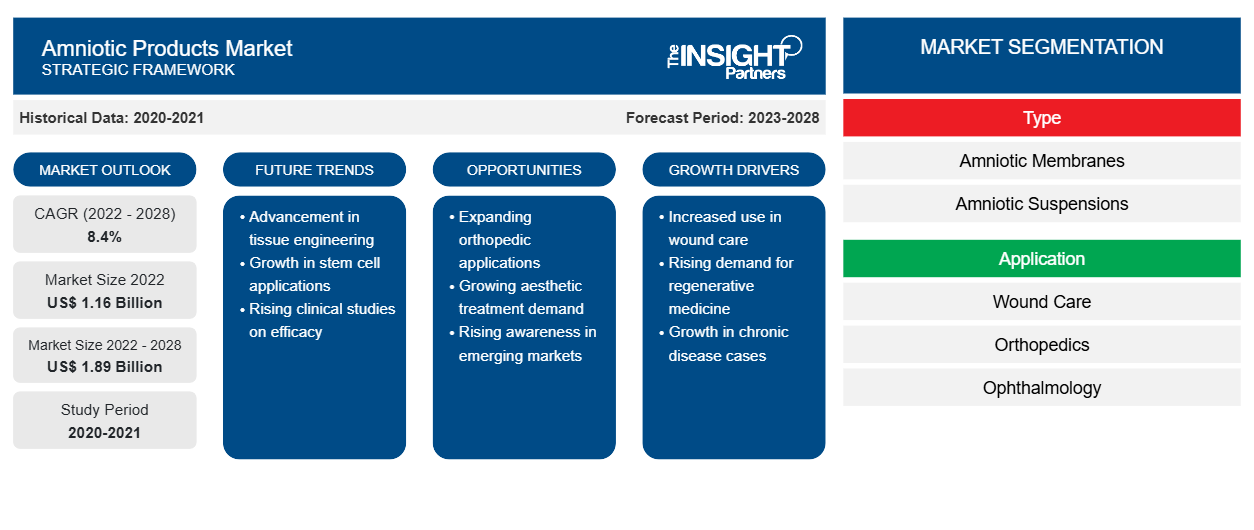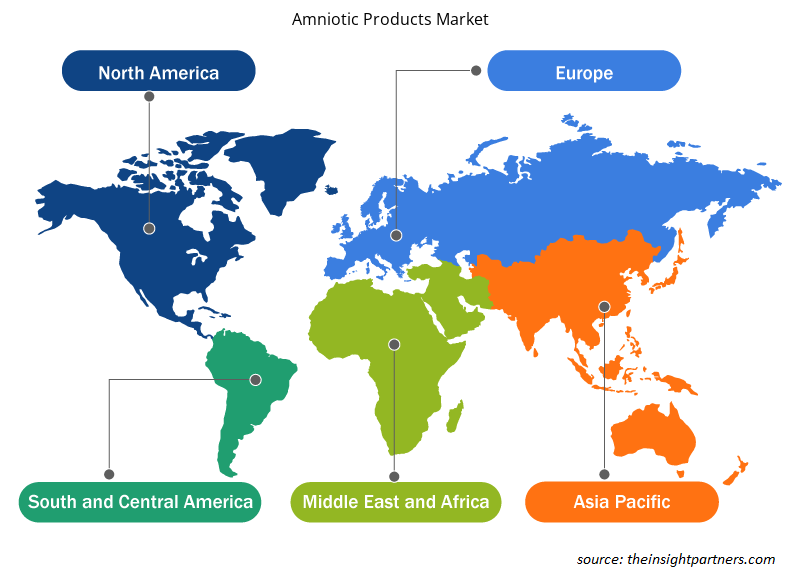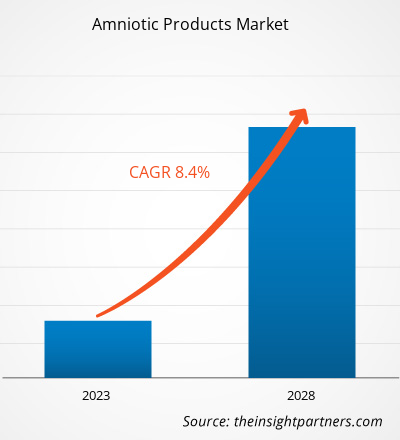[Research Report] The amniotic products market is expected to grow from US$ 1,164.32 million in 2022 to US$ 1,889.07 million by 2028. It is estimated to grow at a CAGR of 8.4% from 2022 to 2028.
Traumatic wounds are a significant clinical, social, and economic burden because of the rising healthcare expenditures, an aging population, identification of difficult-to-treat infection risks such as biofilms, and the global hazard of diabetes and obesity. Traumatic wounds are those that have not proceeded through the normal healing process and have been open for longer than a month. In comparison to the overall burden of chronic wounds as a health care concern, research funding dedicated to studying chronic wounds is disproportionately low. Wound healing using amniotic membrane grafts has some therapeutic potential. Early use of an amniotic membrane for ulcers, burns, and cutaneous injuries proved therapeutic. Therefore, an increasing number of traumatic wounds is boosting the amniotic product market.
The amniotic products market is analyzed into type, application, end user, and geography. By geography, the market is broadly segmented into North America, Europe, Asia Pacific, the Middle East & Africa, and South & Central America. This report offers insights and in-depth analysis of the market, emphasizing parameters, such as market trends, market dynamics, and the competitive analysis of the globally leading market players.
Customize This Report To Suit Your Requirement
You will get customization on any report - free of charge - including parts of this report, or country-level analysis, Excel Data pack, as well as avail great offers and discounts for start-ups & universities
Amniotic Products Market: Strategic Insights

- Get Top Key Market Trends of this report.This FREE sample will include data analysis, ranging from market trends to estimates and forecasts.
You will get customization on any report - free of charge - including parts of this report, or country-level analysis, Excel Data pack, as well as avail great offers and discounts for start-ups & universities
Amniotic Products Market: Strategic Insights

- Get Top Key Market Trends of this report.This FREE sample will include data analysis, ranging from market trends to estimates and forecasts.
Market Insights - Amniotic Products Market
Rising Incidence of Burn Injuries and Increasing Number of Traumatic Wounds to Drive Amniotic Products Market
According to a 2018 retrospective examination of Medicare users, 8.2 million persons suffered wounds that were infected or not. The cost of acute and chronic wound treatments was estimated to cost between US$ 28.1 billion and US$ 96.8 billion by Medicare. Surgical wounds were the most expensive, followed by diabetic foot ulcers, with the cost of outpatient wound care higher than inpatient wound care. Traumatic wound patients are a significant clinical, social, and economic burden because of the rising healthcare expenditures, an aging population, identification of difficult-to-treat infection risks, such as biofilms, and the global hazard of diabetes and obesity.
Compared to the overall burden of chronic wounds as a health care concern, research funding dedicated to studying chronic wounds is disproportionately low. Wound healing using amniotic membrane grafts has some therapeutic potential. Early use of an amniotic membrane for ulcers, burns, and cutaneous injuries proved therapeutic.
Following are a few examples of companies that launched new products developments and product approvals:
- In June 2021, MiMedx Group, Inc. announced successful regulatory approval from the Japanese Ministry of Health, Labor and Welfare (JMHLW), known to market EPIFIX in Japan. With this approval, the company claims that the geographic expansion will increase revenue and customer bases and ensure the company’s growth.
- In February 2020, AmnioExcel Plus was introduced by Integra LifeSciences Holdings Corporation. It is a novel technology that physicians can use in both the operating room and ambulatory wound care setting to help end the epidemic of approximately 8.2 million wounds with an estimated annual cost to Medicare of up to $98.6 billion fight.
Such product developments by market players are driving the amniotic products market.
Type-Based Insights - Amniotic Products Market
Based on type, the amniotic products market has been bifurcated into amniotic membranes and amniotic suspensions. The amniotic membranes segment is likely to hold the largest share of the market in 2022. The amniotic membrane segment growth is growing due to increasing research in stem cell and regenerative medicine, high R&D investments, and an increase in the number of surgeries conducted globally. Further, they are commonly employed in the treatment of bacterial keratitis, corneal ulcers, cataract, glaucoma, bullous keratopathy, corneal degeneration, ocular dystrophy, eyelid reconstruction, and other eye surface problems. The expansion in the world's senior population increases the number of ophthalmology surgeries, , resulting in a growing need for tissue-based products.
Services-Based Insights
Based on application, the global amniotic products market is segmented into wound care, orthopedics, ophthalmology, and other applications. Wound care is a challenging and constantly changing field of medicine. Chronic wounds, in particular, occupy a significant amount of time, effort, and money in the medical community. Due to various factors, including neuropathy, hyperglycemia, infection, and other concurrent disorders, the wounds are more likely to develop chronic.
The human amniotic membrane has been used for nearly a century to treat wounds. Since the early twentieth century, amniotic membrane allografts (AMAs) have been used to treat burns, ulcers, traumatic wounds, surgical incisions, and ocular problems in various medical disciplines. The use of AMAs in treating chronic ulcers is one area where they have acquired a lot of traction. As new preservation techniques and research advances, AMAs have been highly employed in the medical community, particularly in offices and wound care centers. This has also expanded the usage of allografts among physicians who practice non-surgical specialties.
Furthermore, the increasing number of traumatic injuries globally propel the wound care segment. For instance, as per WHO, around 1,000,000 people are severely or moderately burnt annually in India. In addition, as per NCBI, every day, over 30,000 people suffer new burns worldwide, severe enough to warrant medical attention, equating to an estimated 11 million new burns each year globally.
Partnerships and collaborations are highly adopted strategies by the global amniotic products market players. A few of the recent key market developments are listed below:
In June 2021, MiMedx Group, Inc. announced the publication of its peer-reviewed study in the Journal of Investigative Dermatology (JID) Innovations, addressing the potential utility of MiMedx Purion-processed human amniotic/chorionic membrane (dHACM) dehydrated in combating complications of excessive fibrosis, a pathological process central to a number of serious unmet medical needs. It is estimated that more than 100 million people worldwide suffer from pathological scarring each year, including hypertrophic and keloid scarring, with long-term effects ranging in severity from minor cosmetic defects to significantly compromised tissue architecture and dysfunction in a range of conditions. Product development and innovation will strengthen the product portfolio in the near future.
Due to widespread lockdowns, denied wound care services, and cancelled or postponed elective surgeries, the COVID-19 outbreak had a negative impact on the amniotic products market in 2020. Elective procedures were denied (cancelled/postponed) in order to allocate or redirect scarce capacities and resources (such as hospital beds and patient care professionals) to COVID-19 patient care. In addition, to combat the increased number of COVID-19 cases, several countries imposed lockdowns and curfews. Patients were unable to visit hospitals, outpatient clinics, or clinics due to the lockdowns. The amniotic products industry is projected to be limited by this temporary suspension of non-emergent healthcare services. However, in the next years, demand for amniotic products is projected to increase.
Amniotic Products Market Regional Insights
The regional trends and factors influencing the Amniotic Products Market throughout the forecast period have been thoroughly explained by the analysts at The Insight Partners. This section also discusses Amniotic Products Market segments and geography across North America, Europe, Asia Pacific, Middle East and Africa, and South and Central America.

- Get the Regional Specific Data for Amniotic Products Market
Amniotic Products Market Report Scope
| Report Attribute | Details |
|---|---|
| Market size in 2022 | US$ 1.16 Billion |
| Market Size by 2028 | US$ 1.89 Billion |
| Global CAGR (2022 - 2028) | 8.4% |
| Historical Data | 2020-2021 |
| Forecast period | 2023-2028 |
| Segments Covered |
By Type
|
| Regions and Countries Covered | North America
|
| Market leaders and key company profiles |
Amniotic Products Market Players Density: Understanding Its Impact on Business Dynamics
The Amniotic Products Market is growing rapidly, driven by increasing end-user demand due to factors such as evolving consumer preferences, technological advancements, and greater awareness of the product's benefits. As demand rises, businesses are expanding their offerings, innovating to meet consumer needs, and capitalizing on emerging trends, which further fuels market growth.
Market players density refers to the distribution of firms or companies operating within a particular market or industry. It indicates how many competitors (market players) are present in a given market space relative to its size or total market value.
Major Companies operating in the Amniotic Products Market are:
- MiMedx
- Smith & Nephew
- Integra LifeSciences
- Stryker
- Organogenesis
Disclaimer: The companies listed above are not ranked in any particular order.

- Get the Amniotic Products Market top key players overview
Amniotic Products Market Segmentation
The global amniotic products market is analyzed on the basis of type, application, end user, and geography. In terms of type, the market is bifurcated into amniotic membranes and amniotic suspensions. Based on application, the market is segmented into wound care, orthopedics, ophthalmology, and other applications. Based on end user, the market is segmented into hospitals and clinics, ambulatory surgical centers, and other end users. Geographically, the market is segmented into North America, Europe, Asia Pacific, Middle East & Africa, and South & Central America.
Company Profiles
- MiMedx
- Smith & Nephew
- Integra LifeSciences
- Stryker
- Organogenesis
- Katena Products, Inc.
- NuVision Biotherapies Ltd
- Lucina BioSciences
- Next Biosciences
- Sanuwave and Sanuwave Health, Inc.
Frequently Asked Questions
What is the amniotic products market?
Amniotic products are the amniotic tissues and their parts that are used to provide protection and support for the injured tissue and other body parts. The amniotic membrane and suspension are two products that can be used for treatment. The amniotic membrane is the innermost layer of the placenta that nourishes and maintains an unborn child. Amniotic fluid is the liquid that surrounds the baby until delivery.
What are the driving factors for the amniotic products market across the country?
Factors such as the rising incidence of burn injuries and increasing number of traumatic wounds.
What are the restraining factors for the amniotic products market across the country?
The complications and limitations associated with the use of amniotic membranes is expected to restrict the market growth during the forecast period
Who are the major players in market the amniotic products market?
The amniotic products market majorly consists of the players such as MiMedx; Smith & Nephew; Integra Lifesciences; Stryker.; Organogenesis, Inc.; Katena Products, Inc.; NuVision Biotherapies Ltd., Lucina Biosciences.; and Next Biosciences.
Which region is dominating the amniotic products market?
The global amniotic products market on region, is segmented into North America, Europe, Asia Pacific, Middle East & Africa, and the South & Central America. In 2022, North American region held largest market share. However, Asia Pacific region is estimated to grow at the fastest CAGR of 8.8% during the forecast period
Which segment is dominating the amniotic products market?
The global amniotic products market based on type, is segmented into amniotic membranes, and amniotic suspensions. In 2022, amniotic membranes segment held largest market share and the segment is estimated to grow at the fastest CAGR of 8.9% during the forecast period.
- Historical Analysis (2 Years), Base Year, Forecast (7 Years) with CAGR
- PEST and SWOT Analysis
- Market Size Value / Volume - Global, Regional, Country
- Industry and Competitive Landscape
- Excel Dataset
Testimonials
Reason to Buy
- Informed Decision-Making
- Understanding Market Dynamics
- Competitive Analysis
- Identifying Emerging Markets
- Customer Insights
- Market Forecasts
- Risk Mitigation
- Boosting Operational Efficiency
- Strategic Planning
- Investment Justification
- Tracking Industry Innovations
- Aligning with Regulatory Trends
Yes! We provide a free sample of the report, which includes Report Scope (Table of Contents), report structure, and selected insights to help you assess the value of the full report. Please click on the "Download Sample" button or contact us to receive your copy.
Absolutely — analyst assistance is part of the package. You can connect with our analyst post-purchase to clarify report insights, methodology or discuss how the findings apply to your business needs.
Once your order is successfully placed, you will receive a confirmation email along with your invoice.
• For published reports: You’ll receive access to the report within 4–6 working hours via a secured email sent to your email.
• For upcoming reports: Your order will be recorded as a pre-booking. Our team will share the estimated release date and keep you informed of any updates. As soon as the report is published, it will be delivered to your registered email.
We offer customization options to align the report with your specific objectives. Whether you need deeper insights into a particular region, industry segment, competitor analysis, or data cut, our research team can tailor the report accordingly. Please share your requirements with us, and we’ll be happy to provide a customized proposal or scope.
The report is available in either PDF format or as an Excel dataset, depending on the license you choose.
The PDF version provides the full analysis and visuals in a ready-to-read format. The Excel dataset includes all underlying data tables for easy manipulation and further analysis.
Please review the license options at checkout or contact us to confirm which formats are included with your purchase.
Our payment process is fully secure and PCI-DSS compliant.
We use trusted and encrypted payment gateways to ensure that all transactions are protected with industry-standard SSL encryption. Your payment details are never stored on our servers and are handled securely by certified third-party processors.
You can make your purchase with confidence, knowing your personal and financial information is safe with us.
Yes, we do offer special pricing for bulk purchases.
If you're interested in purchasing multiple reports, we’re happy to provide a customized bundle offer or volume-based discount tailored to your needs. Please contact our sales team with the list of reports you’re considering, and we’ll share a personalized quote.
Yes, absolutely.
Our team is available to help you make an informed decision. Whether you have questions about the report’s scope, methodology, customization options, or which license suits you best, we’re here to assist. Please reach out to us at sales@theinsightpartners.com, and one of our representatives will get in touch promptly.
Yes, a billing invoice will be automatically generated and sent to your registered email upon successful completion of your purchase.
If you need the invoice in a specific format or require additional details (such as company name, GST, or VAT information), feel free to contact us, and we’ll be happy to assist.
Yes, certainly.
If you encounter any difficulties accessing or receiving your report, our support team is ready to assist you. Simply reach out to us via email or live chat with your order information, and we’ll ensure the issue is resolved quickly so you can access your report without interruption.















The List of Companies - Amniotic Products Market
- MiMedx
- Smith & Nephew
- Integra LifeSciences
- Stryker
- Organogenesis
- Katena Products, Inc.
- NuVision Biotherapies Ltd.
- Lucina BioSciences
- Next Biosciences
- Sanuwave and Sanuwave Health, Inc.






 Get Free Sample For
Get Free Sample For